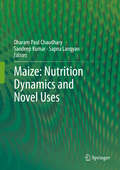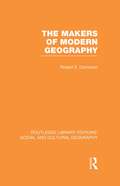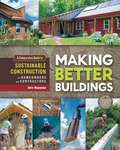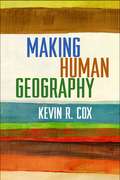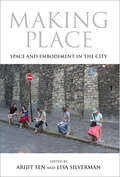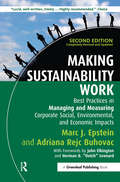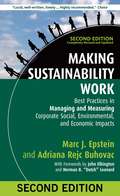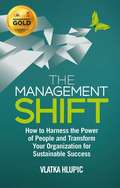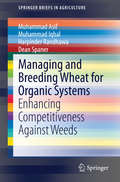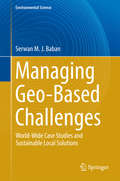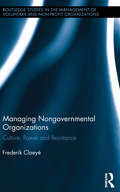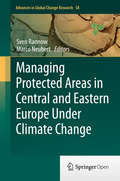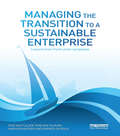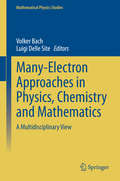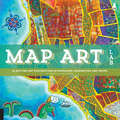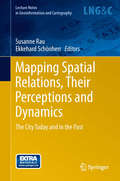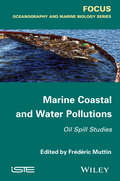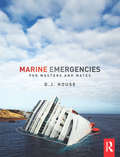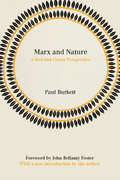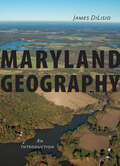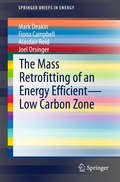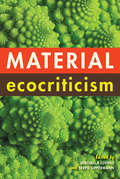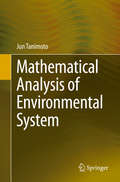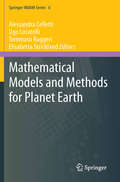- Table View
- List View
Maize: Nutrition Dynamics and Novel Uses
by Dharam Paul Chaudhary Sandeep Kumar Sapna LangyanMaize is a globally important crop mainly utilized as feed, food and raw material for diverse industrial applications. Among cereals, it occupies third place after rice and wheat and is a staple food for a large segment of population worldwide particularly in the Asian as well as African countries. This monogram discusses various aspects of nutritional quality of maize such as quality protein maize which has been considered as most significant discovery in enhancing nutritional quality of cereals in terms of increasing the concentration of essential amino acids. The biochemistry of starch which is an important industrial product of maize has been discussed in detail. Further, the role of maize oil which is highly regarded for human consumption as it reduces the blood cholesterol concentration has also been elaborated. Naturally, maize is a rich source of carotenoids such as beta-carotene, zeaxanthin, lutein, cryptoxanthin which have highly diverse health benefits ranging from maintaining normal vision to lowering of oxidative stress. The need for biofortification of maize for provitamin A carotenoids and their role in alleviating vision impairments have also been discussed. The effect of various biotic and abiotic stresses particularly carbon dioxide and temperature on quality has been discussed thoroughly. Many value-added products as well as fermented foods that have been produced from maize which is consumed in different forms worldwide are also discussed. The aspects related to the maize application as fodder and as a source of malting have also been covered concisely. Overall, the book provides complete information about various quality aspects of maize. The various stakeholders such as maize researchers, extension specialists, students, teachers as well as farmers will be immensely benefitted from this monogram.
The Makers of Modern Geography (Routledge Library Editions: Social and Cultural Geography)
by Robert E. DickinsonThis book examines the works of the outstanding makers of modern geography and demonstrates the consistency of idea and purpose in their work. Geography as an explicitly defined field of knowledge is more than two thousand years old, but as a university subject, geography is only 150 years old, and in this period it has developed hugely. This study traces the development of modern geography as an organized body of knowledge, in the light of the works of its foremost German and French contributors.
Making Better Buildings
by Chris Magwood Jen FeiginMuch has been written about the individual components of sustainable building, but how do you bring it all together into a well-designed whole? Drawing on extensive hands-on experience, Making Better Buildings systematically describes the real-world implications of the most popular green and natural building materials and techniques, objectively presenting the pros, cons and overall viability of each. An indispensable resource.
Making Human Geography
by Kevin R. CoxThis book cogently examines how human geography has developed from a field with limited self-awareness regarding method and theory to the vibrant study of society and space that it is today. Kevin R. Cox provides an interpretive, critical perspective on Anglo-American geographic thought in the 20th and 21st centuries. He probes the impact of the spatial-quantitative revolution and geography's engagement with other social sciences, particularly in social theory. Key concepts and theories in the field are explained and illustrated with instructive research examples. Cox explores both how new approaches to human geography get constructed and what each school of thought has contributed to understanding the world in which we live.
Making Place: Space And Embodiment In The City
by Arijit Sen Lisa SilvermanSpace and place have become central to analysis of culture and history in the humanities and social sciences. Making Place examines how people engage the material and social worlds of the urban environment via the rhythms of everyday life and how bodily responses are implicated in the making and experiencing of place. The contributors introduce the concept of spatial ethnography, a new methodological approach that incorporates both material and abstract perspectives in the study of people and place, and encourages consideration of the various levels--from the personal to the planetary--at which spatial change occurs. The book's case studies come from Costa Rica, Colombia, India, Austria, Italy, the United Kingdom, and the United States.
Making Sustainability Work: Best Practices in Managing and Measuring Corporate Social, Environmental and Economic Impacts
by Marc J. Epstein Adriana Rejc BuhovacThe ultimate "how-to-do-it" guide for corporate leaders, strategists, academics, sustainability consultants, and anyone else with an interest in actually making sustainability work for organizations. An updated edition of a landmark book at a time when a growing number of corporate leaders are asking for urgent help in "getting this done".
Making Sustainability Work: Best Practices in Managing and Measuring Corporate Social, Environmental and Economic Impacts
by Adriana Rejc Buhovac Marc J. EpsteinNEW EDITION, REVISED AND UPDATED Most companies today have some commitment to corporate social responsibility, but implementing these initiatives can be particularly challenging. While a lot has been written on ethical and strategic factors, there is still a dearth of information on the practical nuts and bolts. And whereas with most other organizational initiatives the sole objective is improved financial performance, sustainability broadens the focus to include social and environmental performance, which is much more difficult to measure. Now updated throughout with new examples and new research, this is a complete guide to implementing and measuring the effectiveness of sustainability initiatives. It draws on Marc Epstein's and new coauthor Adriana Rejc Buhovac's solid academic foundation and extensive consulting work and includes best practices from dozens of companies in Europe, Asia, North America, South America, Australia, and Africa. This is the ultimate how-to guide for corporate leaders, strategists, academics, sustainability consultants, and anyone else with an interest in actually putting sustainability ideas into practice and making sure they accomplish their goals.
The Management Shift: How to Harness the Power of People and Transform Your Organization for Sustainable Success
by Vlatka Hlupic<p>Research shows that corporate life expectancy and performance have declined 75% in the last 50 years - organizations need a different approach if they are to survive, let alone thrive. <p>While people are often stated as a company's greatest asset, few businesses have a clear model of leadership that improves engagement, removes barriers to innovation, and uncovers hidden strengths in people and the organization. This book addresses that need and, more importantly, demonstrates HOW organizations can make The Management Shift to a new way of thinking and working. Professor Hlupic argues that organizations now need to adopt a leadership style that focuses on people, purpose and knowledge sharing, creating new types of value and ultimately improving innovation and engagement - leading to improved business. <p>Based on leading-edge research supported by numerous case studies, which demonstrate the power and impact of change, The Management Shift offers managers a practical and systemic approach to diagnose leadership issues in their organization. It then provides an implementation process to shift their mindset and organizational culture to the new level of thinking, performance, and ultimately business success.</p>
Managing and Breeding Wheat for Organic Systems
by Muhammad Asif Muhammad Iqbal Harpinder Randhawa Dean SpanerGenetically uniform cultivars in many self-pollinated cereal crops dominate commercial production in high-input environments especially due to their high grain yields and wide geographical adaptation. These cultivars generally perform well under favorable and high-input farming systems but their optimal performance cannot be achieved on marginal/organic lands or without the use of external chemical inputs (fertilizers, herbicides and pesticides). Cereal breeding programs aim at evaluating candidate lines/cultivars for agronomic, disease and quality traits in a weed free environment that makes it impossible to identify traits conferring competitive ability against weeds. Moreover, quantification of competitive ability is a complex phenomenon which is affected by range of growth traits. Above (e. g. light) and below (e. g. water and nutrients) ground resources also influence competitiveness to a greater extent. Competitiveness is quantitatively inherited trait which is heavily influenced by many factors including genotype, management, environment and their interaction. Sound plant breeding techniques and good experimental designs are prerequisites for maximizing genetic gains to breed cultivars for organically managed lands. The brief is focused on breeding wheat for enhanced competitive ability along with other agronomic, genetic and molecular studies that have been undertaken to improve weed suppression, disease resistance and quality in organically managed lands. The examples from other cereals have also been highlighted to compare wheat with other cereal crops.
Managing Geo-Based Challenges
by Serwan M. J. BabanThis book provides sound conceptual understanding of the current approach to management and decision making regarding geo-based challenges in developing countries that tend to suffer from information poverty and subjectivity and are reactive. The book also provides the necessary technical tools to energize research thinking and develop locally driven practical and sustainable solutions, ultimately moving management and decision making from being reactive to being proactive. This book fills a void as there are no published books to show the way forward or to present real case studies for this purpose. Case studies that utilize new technologies and scientific thinking are presented for developing sustainable management options based either on producing local applied research or on utilising relevant international research. These case studies are based on the author's first-hand experiences in arid/semi-arid (Iraq, Tunisia, Morocco and Jordan), temperate (UK) and tropical environments (Malaysia, the Caribbean region, Indonesia and Australia).
Managing Nongovernmental Organizations: Culture, Power and Resistance (Routledge Studies in the Management of Voluntary and Non-Profit Organizations)
by Frederik ClaeyéThe idea that international development aid needs to be better managed and coordinated gained currency in the early 1990s. The increasing emphasis on management has resulted in the present vogue of ‘managing for development results’ as one of the central tenets in the discourse on international aid. But how appropriate are these ideas, tools, and techniques for non-governmental development organizations (NGOs), and how much does geographic context matter? Examining the current debate on aid effectiveness and the role of NGOs in contributing to it, this book highlights the critical importance of understanding how the global and the local interact to increase aid efficacy and develop more culturally astute ways of managing NGOs. With a focus on NGOs active in sub-Saharan Africa as case studies, author Frederik Claeyé demonstrates that NGOs are not mere passive recipients of management knowledge and practices emanating from the global governance structure of international aid, but actively engage with these ideas and practices to translate and rework them through a local cultural lens. This process results in the emergence of unique hybrid management systems that combine the pressure to become more business-like with the mission to satisfy the demands of the communities they serve.
Managing Protected Areas in Central and Eastern Europe Under Climate Change
by Sven Rannow Marco NeubertBeginning with an overview of data and concepts developed in the EU-project HABIT-CHANGE, this book addresses the need for sharing knowledge and experience in the field of biodiversity conservation and climate change. There is an urgent need to build capacity in protected areas to monitor, assess, manage and report the effects of climate change and their interaction with other pressures. The contributors identify barriers to the adaptation of conservation management, such as the mismatch between planning reality and the decision context at site level. Short and vivid descriptions of case studies, drawn from investigation areas all over Central and Eastern Europe, illustrate both the local impacts of climate change and their consequences for future management. These focus on ecosystems most vulnerable to changes in climatic conditions, including alpine areas, wetlands, forests, lowland grasslands and coastal areas. The case studies demonstrate the application of adaptation strategies in protected areas like National Parks, Biosphere Reserves and Natural Parks, and reflect the potential benefits as well as existing obstacles. A general section provides the necessary background information on climate trends and their effects on abiotic and biotic components. Often, the parties to policy change and conservation management, including managers, land users and stakeholders, lack both expertise and incentives to undertake adaptation activities. The authors recognise that achieving the needed changes in behavior - habit - is as much a social learning process as a matter of science-based procedure. They describe the implementation of modeling, impact assessment and monitoring of climate conditions, and show how the results can support efforts to increase stakeholder involvement in local adaptation strategies. The book concludes by pointing out the need for more work to communicate the cross-sectoral nature of biodiversity protection, the value of well-informed planning in the long-term process of adaptation, the definition of acceptable change, and the motivational value of exchanging experience and examples of good practice.
Managing the Transition to a Sustainable Enterprise: Lessons from Frontrunner Companies
by Rob van Tulder Rob van Tilburg Mara Francken Andrea da RosaIn combining practice and theory, this textbook provides a management perspective on the ‘business case’ for sustainability. Drawing on examples from 20 frontrunner companies located in the Netherlands, it builds upon a unique research project in which CEOs and middle-managers gave access not only to their decision-making process, but also revealed how their perceptions shaped the transition process. This book identifies four different archetypes of business cases and related business models that business students and managers can use to identify phases and related attitudes towards sustainability. The book provides in-depth analysis and insight into: • theoretical concepts and an overview of the relevant literature • the different business cases for sustainability • behavioural characteristics of each phase and the typical barriers between them • more than 70 tipping points • approaches to shaping stakeholder dialogue • effective engagement of stakeholders in each phase of transition • how companies move through the phases towards higher levels of sustainability • insights of employees of the 20 companies whether the business case was really achieved • summary of the interventions which have proved successful in these companies. This book offers students as well as managers of vocational and academic institutions at undergraduate and postgraduate level insight into real-life transition processes towards sustainability.
Manifolds, Tensors, and Forms
by Paul RentelnProviding a succinct yet comprehensive treatment of the essentials of modern differential geometry and topology, this book's clear prose and informal style make it accessible to advanced undergraduate and graduate students in mathematics and the physical sciences. The text covers the basics of multilinear algebra, differentiation and integration on manifolds, Lie groups and Lie algebras, homotopy and de Rham cohomology, homology, vector bundles, Riemannian and pseudo-Riemannian geometry, and degree theory. It also features over 250 detailed exercises, and a variety of applications revealing fundamental connections to classical mechanics, electromagnetism (including circuit theory), general relativity and gauge theory. Solutions to the problems are available for instructors at www. cambridge. org/9781107042193.
Many-Electron Approaches in Physics, Chemistry and Mathematics
by Volker Bach Luigi Delle SiteThis book provides a broad description of the development and (computational) application of many-electron approaches from a multidisciplinary perspective. In the context of studying many-electron systems Computer Science, Chemistry, Mathematics and Physics are all intimately interconnected. However, beyond a handful of communities working at the interface between these disciplines, there is still a marked separation of subjects. This book seeks to offer a common platform for possible exchanges between the various fields and to introduce the reader to perspectives for potential further developments across the disciplines. The rapid advances of modern technology will inevitably require substantial improvements in the approaches currently used, which will in turn make exchanges between disciplines indispensable. In essence this book is one of the very first attempts at an interdisciplinary approach to the many-electron problem.
Map Art Lab: 52 Exciting Art Explorations in Map Making, Imagination, and Travel (Lab)
by Jill K. Berry Linden McNeillyExplore the world of cartography with this collection of creative map-related projects—for artists of all ages and experience levels.This fun and creative book features fifty-two map-related activities set into weekly exercises, beginning with legends and lines, moving through types and styles, and then creating personalized maps that allow you to journey to new worlds. Authors Jill K. Berry and Linden McNeilly guide you through useful concepts while exploring colorful, eye-catching graphics.Maps are beautiful and fascinating, they teach you things, and they show you where you are, places you long to go, and places you dare to imagine. The labs can be used as singular projects or to build up to a year of hands-on creative experiences. Map Art Lab is the perfect book for map lovers and DIY-inspired designers. Artists of all ages and experience levels can use this book to explore enjoyable and engaging exercises.“Learn about cartography, topography, legends, compasses, and more in this adventurous DIY map book.” —Cloth Paper Scissors Magazine“Every art teacher should have a copy of this book.” —Katharine Harmon, author of The Map as Art: Contemporary Artists Explore Cartography
Mapping Spatial Relations, Their Perceptions and Dynamics
by Susanne Rau Ekkehard SchönherrThis book is the product of an eponymous workshop, which took place in Erfurt in May, 2012, and which has since then been supplemented with four further contributions. The topics focus on the potential mapping of perceived urban space and spatial hierarchies as a consequence of social usage (undertaken by a variety of active participants) together with spatio-temporal changes as a result of factors such as demographic urban growth and decline. Historians, cartographers and geographers are brought together to present and discuss different models, ideas and new methods of spatial analysis and modes of representing changes in perceptions. The two main subjects are: the epistemology of spatial change and the question of (historical) media and adequate presentation. This work represents a first step toward the development of a new model for mapping urban changes and spatial relations concerning the past, present and future.
Marine Coastal and Water Pollutions: Oil Spill Studies
by Frédéric MuttinIdentifying efficient solutions to protect coastal regions from marine pollution requires expertise from a range of specialties and strategic approaches. This book gathers information on the impact of oil spills at a coastal level from different experts’ points of view, identifying synergies between domains such as mathematics, numerical modeling, mechanics, biology, economics and law. The collaborative research presented here is based on the 4th International Workshop on Anti-Pollution and Marine Coastal Water Pollution, held in La Rochelle, France at the Engineering School EIGSI, in April 2012. The areas addressed include: materials and structures (fluid-structure and capture interaction, cable and membrane equations, optimization); coastal hydrodynamics (computational fluid dynamics, numerical analysis of shallow water equations, analytical and numerical derivatives); biological impacts (biology, multivariate analysis, indicators); and economics and law (compensation costs, insurance coverage, coastal vulnerability).
Marine Emergencies: For Masters and Mates
by David HouseAn influential guide to maritime emergencies and the current strategies that can be employed to cope with the immediate after effects and ramifications of disaster at sea. Many mariners will at some point in their maritime careers become involved in one sort of emergency or another, while in port or at sea, whether it is a fire on board, a collision with another vessel or an engine failure threatening a lee shore. Actions to take in such incidents can be the difference between survival and catastrophic loss. This text provides a direct insight into some of the latest incidents and includes: case studies from emergencies worldwide checklists and suggestions for emergency situations. everything from fire and collision right through to the legal implications of salvage. David House has now written and published eighteen marine titles, many of which are in multiple editions. After commencing his seagoing career in 1962, he was initially engaged on general cargo vessels. He later experienced worldwide trade with passenger, container, Ro-Ro, reefer ships and bulk cargoes. He left the sea in 1978 with a Master Mariner's qualification and commenced teaching at the Fleetwood Nautical College. He retired in 2012 after thirty three years of teaching in nautical education. He continues to write and research maritime aspects for future works.
Maryland Geography: An Introduction
by James DiLisioA grand tour of Maryland’s geographic past through the lens of today’s landscape.When he first laid eyes on the countryside around Chesapeake Bay in 1608, records reveal, Captain John Smith exclaimed, "Heaven and earth seemed never to have agreed better to frame a place for man’s habitation." In Maryland Geography, James DiLisio—another admirer of the Free State—pays tribute to Maryland’s rich cultural, historical, and geographical heritage. This up-to-date, in-depth account interprets the contemporary environmental conditions of the "Marylandscape" by emphasizing its evolving political and socioeconomic contours.This closely researched volume, which is loaded with instructive charts and maps, is the result of DiLisio’s lifelong fascination with the geography of his adopted state and his thirty-five years teaching Maryland geography at Towson University. Arguing that regional geography is a product of both natural and human events, Maryland Geography provides an account of the vital geographical stage that the people of Maryland have created.DiLisio touches on Maryland’s pre-European American Indian heritage, post-colonial agriculture, and shifting industrial geography, as well as the degradation of the Chesapeake Bay and the rise of the modern economy. He considers the emergence of the isolated Eastern Shore; the rural tobacco land of southern Maryland; the rugged mining area of western Maryland; the prosperous, mixed farming area of the Piedmont; and the metropolitan Baltimore-Washington corridor. More than descriptive, the book examines major trends in the state—natural, economic, and demographic—in a way that prompts thinking about the consequences of growth and unbridled development. Aimed at college-level geography students, the book will also be of great interest to general readers, historians, politicians, and anyone involved in making policies relating to Maryland places.
The Mass Retrofitting of an Energy Efficient--Low Carbon Zone
by Mark Deakin Fiona Campbell Alasdair Reid Joel OrsingerMaximizing reader insights into the strategic value of mass retrofits in the residential property sector through a detailed case study analysis of the 'Hackbridge project', this book uses this development to broaden understanding of how planners may perform urban regeneration in accordance with a centralized plan. This book demonstrates how urban morphology matters, not only with respect to either the geometry of design and construction systems, or occupational behaviours, but with regards to the potential with which the planning, (re)development, design, construction, use and occupation of buildings, has to not only lower levels of energy consumption and rates of carbon emission, but also to reduce global warming associated with climate change. Delivering a critique of the state-of-the-art on urban morphology, the geometry of design typologies, construction systems and occupational behaviours and armed with the critical insights this offers, this book offers a context-specific analysis of how institutions can begin to actively plan for, integrate and sustain the development of energy efficient-low carbon zones.
Material Ecocriticism
by Serpil Oppermann Serenella IovinoMaterial Ecocriticism offers new ways to analyze language and reality, human and nonhuman life, mind and matter, without falling into well-worn paths of thinking. Bringing ecocriticism closer to the material turn, the contributions to this landmark volume focus on material forces and substances, the agency of things, processes, narratives and stories, and making meaning out of the world. This broad-ranging reflection on contemporary human experience and expression provokes new understandings of the planet to which we are intimately connected.
Mathematical Analysis of Environmental System
by Jun TanimotoThis book is for all graduate students who are specializing in any environmental issue and who wish to grasp the fundamentals of physics that are required in various fields of science and engineering. The book provides the structural concept of the system state equation and its dynamics, which can be applicable to numerical solutions in several important areas such as heat and mass transfer and fluid dynamics. As a first step, there is a description of how to solve a linear system by conducting an analysis of temperature distribution in an infinite soil as a practical example. This exercise helps readers to fully understand what time and space discretizations are, and how actual numerical solutions should work. Because the concept of the system state equation relies on a vector-matrix form, the book shows how that particular form is applicable to other practical procedures: linear multi regression analysis, the least square method, and others. The book also gives the solution to non-linear dynamical systems and their applications. Although this book may appear to take an unusual approach, the author believes it will be inspiring and greatly helpful for the beginner who seeks a solid understanding of the basis of mathematics and physics for any environmental problems.
Mathematical Models and Methods for Planet Earth
by Alessandra Celletti Ugo Locatelli Tommaso Ruggeri Elisabetta StricklandIn 2013 several scientific activities have been devoted to mathematical researches for the study of planet Earth. The current volume presents a selection of the highly topical issues presented at the workshop "Mathematical Models and Methods for Planet Earth", held in Roma (Italy), in May 2013. The fields of interest span from impacts of dangerous asteroids to the safeguard from space debris, from climatic changes to monitoring geological events, from the study of tumor growth to sociological problems. In all these fields the mathematical studies play a relevant role as a tool for the analysis of specific topics and as an ingredient of multidisciplinary problems. To investigate these problems we will see many different mathematical tools at work: just to mention some, stochastic processes, PDE, normal forms, chaos theory.
